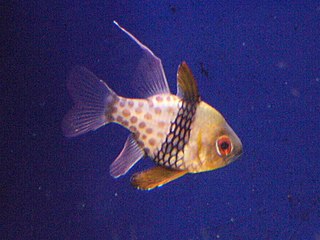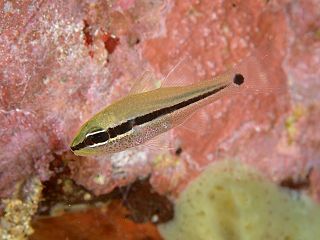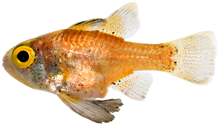
Apogon is a large genus of fish in the family Apogonidae, the cardinalfishes. They are among the most common fish on coral reefs. Over 200 species have been classified in genus Apogon as members of several subgenera. Some of these subgenera, such as Ostorhinchus, have been elevated to genus status, leaving just over 50 species in the genus.

Sphaeramia is a genus of the Apogonidae (cardinalfishes). They are marine fish that live in shallow tropical reefs in the Indian and Pacific Oceans

Nectamia is a genus of cardinalfishes native to the Indian Ocean and the western and central Pacific Ocean.

Vincentia is a genus of cardinalfishes native to the eastern Indian Ocean and the southwestern Pacific Ocean. The generic name refers to Gulf St Vincent in South Australia, where the type specimen of V. waterhousii was collected.

Apogonichthyoides is a genus of fish in the family Apogonidae, the cardinalfishes. They are native to the Indian Ocean and the western Pacific Ocean.

Cheilodipterus is a genus of fishes in the family Apogonidae, the cardinalfishes. They are native to the Indian Ocean and the western Pacific Ocean.

Foa is a genus of fishes in the family Apogonidae, the cardinalfishes, native to the Indian and Pacific Oceans.

Fowleria is a genus of fishes in the family Apogonidae native to the Indian and Pacific Oceans. The name of this genus honors the American ichthyologist Henry Weed Fowler ( ) of the Academy of Natural Sciences of Philadelphia, who attended Stanford University, where he was a student of David Starr Jordan's.

Gymnapogon is a genus of fish in the family Apogonidae. They are native to the Indo-West Pacific and central Pacific Oceans, where they occur in reefs and nearby habitat types. These species are usually no more than 5 centimeters long and have semitransparent bodies without scales. The genus name is a compound noun formed by combining the Greek gymnos meaning "naked", referring to the lack of scales in the type species, Gymnapogon japonicus, and Apogon, the type genus of the Apogonidae. One species, the B-spot cardinalfish, is notable for its larvae being rather large, conspicuous and fast-swimming.
Lachneratus phasmaticus, also known as the phantom cardinalfish, is a species of fish in the family Apogonidae, the cardinalfishes. It is the only member of its genus. It is native to the tropical eastern Pacific and Indian Oceans. This fish can be found in crevices and underwater caves, and it occurs at depths of 3 to 104 m. It grows to a standard length of 7.4 cm (2.9 in).

Lepidamia is a genus of fishes in the family Apogonidae, the cardinalfishes.
Neamia is a genus of cardinalfishes native to the Indian Ocean and the western Pacific Ocean.

Ostorhinchus is a genus of ray-finned fish in the family Apogonidae native to the Indian and Pacific Oceans.

Pristiapogon is a genus of cardinalfishes native to the Indian and Pacific Oceans.

Pristicon is a genus of cardinalfishes native to the western Pacific Ocean.
Pseudamia is a genus of cardinalfishes native to the Indian and Pacific oceans.
Pseudamiops is a genus of cardinalfishes native to the Pacific and Indian oceans.

Rhabdamia is a genus of cardinalfishes native to the Indian and Pacific Oceans.

Zoramia is a genus of cardinalfishes native to the Indian and Pacific Ocean.

Taeniamia is a genus of cardinalfishes native to the Indian Ocean and the western Pacific Ocean.

















